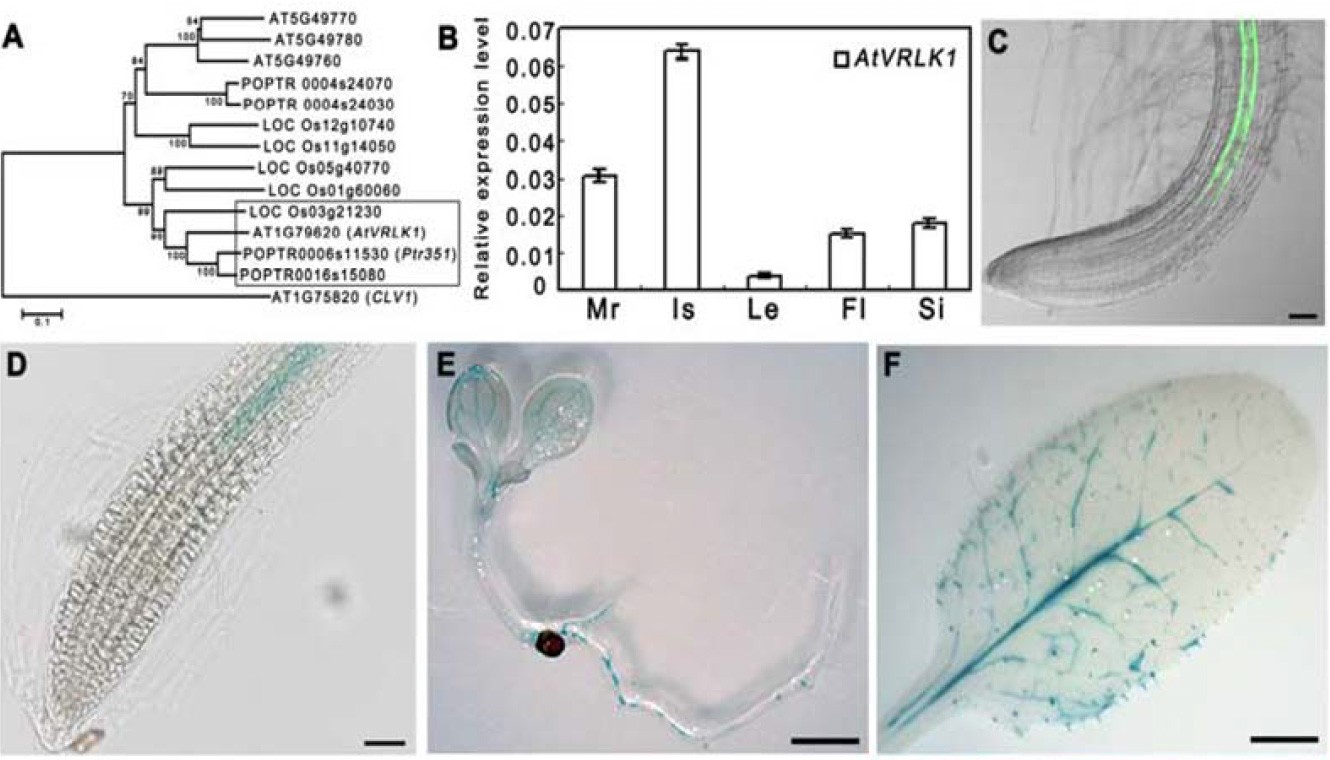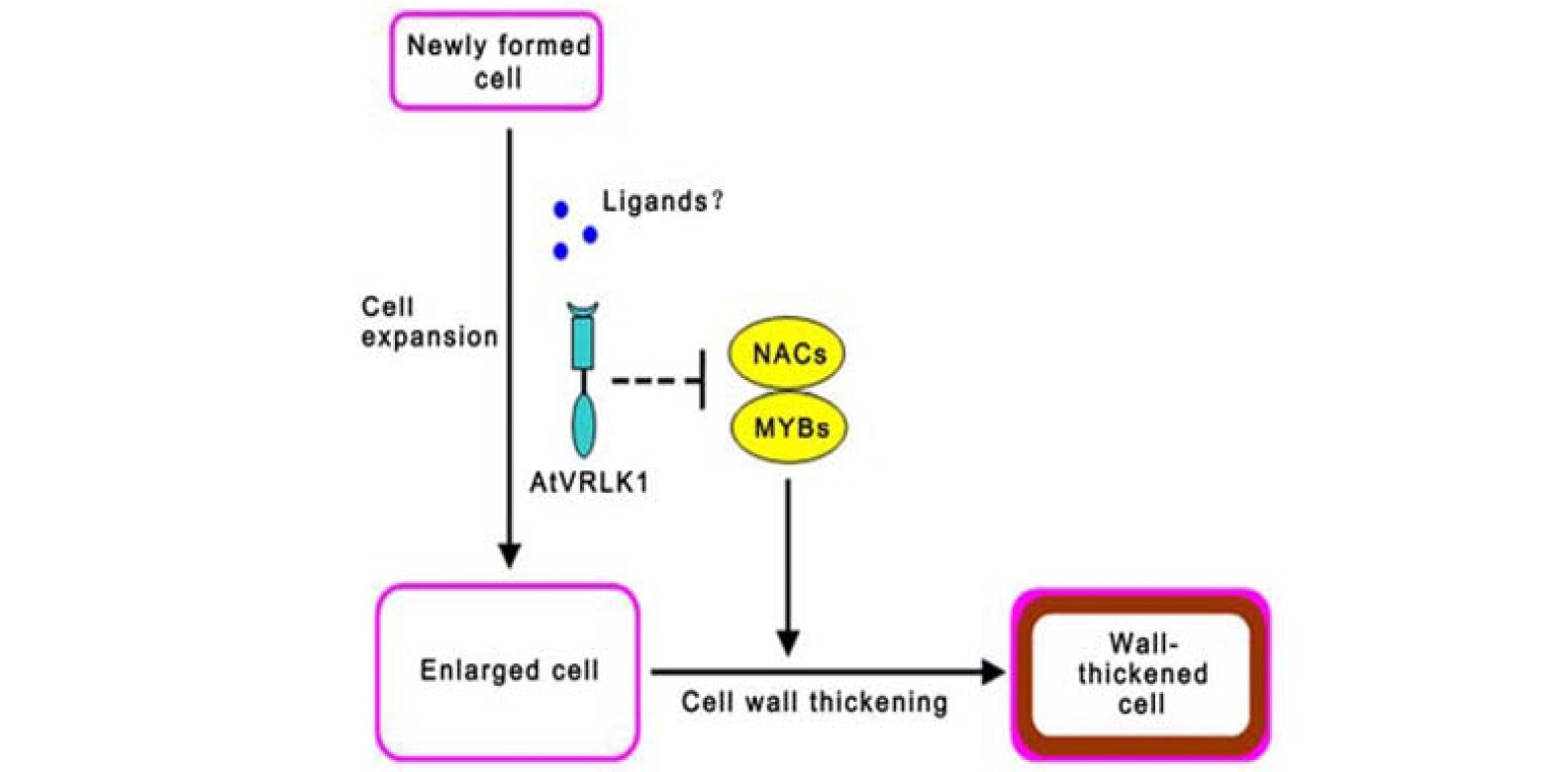博文
Plant Physiology:拟南芥受体激酶AtVRLK1调控次生细胞壁加厚
||
The receptor-like kinase AtVRLK1 regulates secondary cell wall thickening
First author: Cheng Huang; Affiliations: Institute of Plant Physiology and Ecology, Chinese Academy of Sciences (中科院植物生理生态研究所): Shanghai, China
Corresponding author: Laigeng Li
During the growth and development of land plants, some specialized cells, such as tracheary elements (导管分子), undergo secondary cell wall thickening. Secondary cell walls contain additional lignin, compared with primary cell walls, thus providing mechanical strength and potentially improving defenses against pathogens. However, the molecular mechanisms that initiate wall thickening are unknown. In this study, we identified an Arabidopsis thalianaleucine-rich repeat receptor-like kinase, encoded by AtVRLK1(Vascular-Related RLK 1), that is specifically expressed in cells undergoing secondary cell wall thickening. Suppression of AtVRLK1expression resulted in a range of phenotypes that included retarded (减速) early elongation of the inflorescence stem, shorter fibers, slower root growth, and shorter flower filaments (花丝). In contrast, upregulation of AtVRLK1led to longer fiber cells, reduced secondary cell wall thickening in fiber and vessel cells, and defects in anther dehiscence (花药开裂). Molecular and cellular analyses showed that downregulation of AtVRLK1promoted secondary cell wall thickening and upregulation of AtVRLK1enhanced cell elongation and inhibited secondary cell wall thickening. We propose that AtVRLK1 functions as a signaling component in coordinating cell elongation and cell wall thickening during growth and development.
在植物的生长和发育过程中,诸如导管分子等一些特异的细胞会经历次生细胞壁加厚过程。相比于初生细胞壁,次生细胞壁具有额外的木质素,这会导致机械强度增加,并潜在提升对于病原菌的抗性。然而,目前对于次生细胞壁加厚的起始机理还不清楚。本文鉴定了一个拟南芥亮氨酸重复类受体激酶AtVRLK1基因,其特异在经历次生细胞壁加厚的细胞中表达。抑制AtVRLK1基因的表达会导致诸多表型的变化,比如花序轴早期伸长减缓、纤维变短、根生长减缓、花丝长度变短。相反,上调AtVRLK1基因的表达则会导致纤维细胞增长,纤维和维管细胞中次生细胞壁加厚减少,并且花药开裂存在缺陷。分子和细胞学试验显示下调AtVRLK1基因的表达会促进次生细胞壁加厚,而上调AtVRLK1基因的表达会增强细胞伸长和起始次生细胞壁加厚。作者提出AtVRLK1可能作为植物生长发育过程中调控细胞伸长和细胞壁加厚之间平衡的信号组份。
通讯:李来庚(http://sourcedb.sibs.cas.cn/zw/rck/200906/t20090629_1856166.html)
个人简介:1982年,中南林学院,学士;1985年,中南林学院,硕士;1997年,Michigan Technological University,博士。
研究方向: 1. 植物细胞壁生物合成的分子生物学与基因工程研究; 2. 木质部细胞分化的分子调控机理研究; 3. 木质纤维生物质合成的功能基因组学研究; 4. 有效利用木质纤维生物质能源的技术研究。
doi: https://doi.org/10.1104/pp.17.01279
Journal: Plant Physiology
First Published date: 20 April, 2018
(P.S. 欢迎关注微信公众号:微信号Plant_Frontiers)
https://blog.sciencenet.cn/blog-3158122-1110229.html
上一篇:New Phytologist:昼夜节律影响自然条件下的茎尖结构
下一篇:CRIT REV PLANT SCI:模式植物和作物中WRKY转录因子家族
全部作者的其他最新博文
- • Plant Physiology:CsMADS3促进柑果中的叶绿素降解和类胡萝卜素合成(华中农业大学)
- • Molecular Plant:LBD11-ROS反馈调节作用于拟南芥的维管形成层增殖和次生生长(浦项科技大学)
- • Science Advances:根结线虫通过调控植物的CLE3-CLV1模块,促进侵染进程(日本熊本大学)
- • Nature Communications:油菜素内酯参与植物营养生长期转变的分子机制解析(浙江农林大学)
- • Current Biology:光合作用产生的蔗糖驱动侧根“生物钟”(德国弗莱堡大学)
- • PNAS:花同源异型基因在叶中被抑制、花中被激活的分子机制(南卡罗来纳大学)


